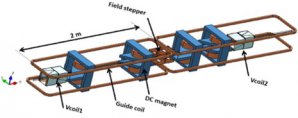The Netherlands: Compact instrumentation for Larmor Labelling applications for the ESS

Schematic drawing of SEMSANS arrangement considered for the magnetic field calculations.
Neutron Spin Echo methods (NSE) use Larmor labelling to measure the precession phase of the neutron beam polarization around well-defined magnetic fields. Scattering by a sample can affect the resulting precession phase and amplitude and this information can be used to provide information on the sample’s structure and dynamics with high accuracy and resolution.
A big advantage of Larmor labelling applications is that resolution is not coupled to beam characteristics like collimation and monochromatisation and thus they do not trade resolution for neutron intensity. Ideally, to make full use of this, these instruments should combine high magnetic fields with a compact design so the neutron flux can be maximised. However, due to the homogeneity requirements of the precession magnetic fields, existing set-ups are relatively long, which in reality collimates the beam and reduces the neutron flux.
In the frame of the SINE2020 project, scientists at Delft University of Technology (TUD), in The Netherlands, investigated the influence of the new moderator, which is being built at the European Spallation Source, on the design of Larmor labelling instruments. This moderator will have an innovative flat “pancake” design, which will lead to small beam cross-sections with increased neutron brightness. Thus, it will be well adapted for compact instrumentation and small samples.
Andre Kusmin, Michel Thijs, Jeroen Plomp and Catherine Pappas used magnetic field calculations to evaluate the performance at the ESS of two possible compact magnetic field configurations, one for NSE spectroscopy and another one for SEMSANS (Spin-echo Modulation Small-Angle Neutron Scattering). Both configurations would combine a high instrument performance with a high neutron flux and could be recommended as instrumental concepts.
Conclusions
Neutron Spin Echo spectroscopy
The calculations show clear gains if the height to width ratios of the rectangular beam cross-sections mimic those of the ESS pancake moderator beams. In such a case the homogeneity of the magnetic field integrals could improve by at least 30%. However, it will not be possible to preserve a high resolution and at the same time reduce the length of the instrument. Consequently, NSE spectrometers will perform better at the ESS but they will not be substantially more compact than at other neutron sources e.g. ILL in France or FRM II in Germany.
SEMSANS
The results show that with the pancake moderator neutron beams, the overall length of such an instrument can be reduced substantially from about 3m to about 1m. This would lead to compact set-ups that could be easily implemented as options on existing instruments, i.e. they could be added or removed according to the experimental requirements. These options would substantially extend the capabilities of the ESS instrumentation, for example by allowing simultaneous SANS and SEMSANS measurements. Possible host instruments could be the polarized neutron SANS instrument SKAGI or the imaging station ODIN. In the latter, the SEMSANS add-on could be used for high resolution dark field imaging.
The work of the TU Delft team will be transferred to the ESS team in the form of recommendations, produced as one of the deliverables of the SINE2020 project.
Acknowledgements: Catherine Pappas, TUD
Back to The Road to the ESS